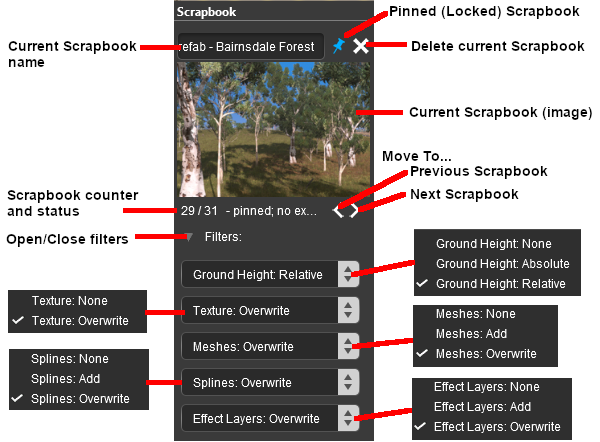How to Use S20 Palettes
(Created page with "The information in this Wiki Page applies to '''Surveyor 2.0 (S20)''' as found in '''Trainz Plus'''. The original refernce material for this document can be found at [[image:W...") |
m |
||
| Line 908: | Line 908: | ||
<br> | <br> | ||
| − | ='''The Fine Adjustment Tool'''= | + | =='''The Fine Adjustment Tool'''== |
<table width=1000> | <table width=1000> | ||
| Line 919: | Line 919: | ||
<br> | <br> | ||
| − | ='''The Marquee Tool'''= | + | =='''The Marquee Tool'''== |
<table width=1000> | <table width=1000> | ||
Revision as of 20:24, 19 February 2023
The information in this Wiki Page applies to Surveyor 2.0 (S20) as found in Trainz Plus. The original refernce material for this document can be found at Surveyor 2.0 Overview
|
This document is still under construction |
The Surveyor 2.0 World
When you start Trainz in Survayor 2.0 the world presented will look something like the following image, but what you actually see can be highly customised to yur own preferences.
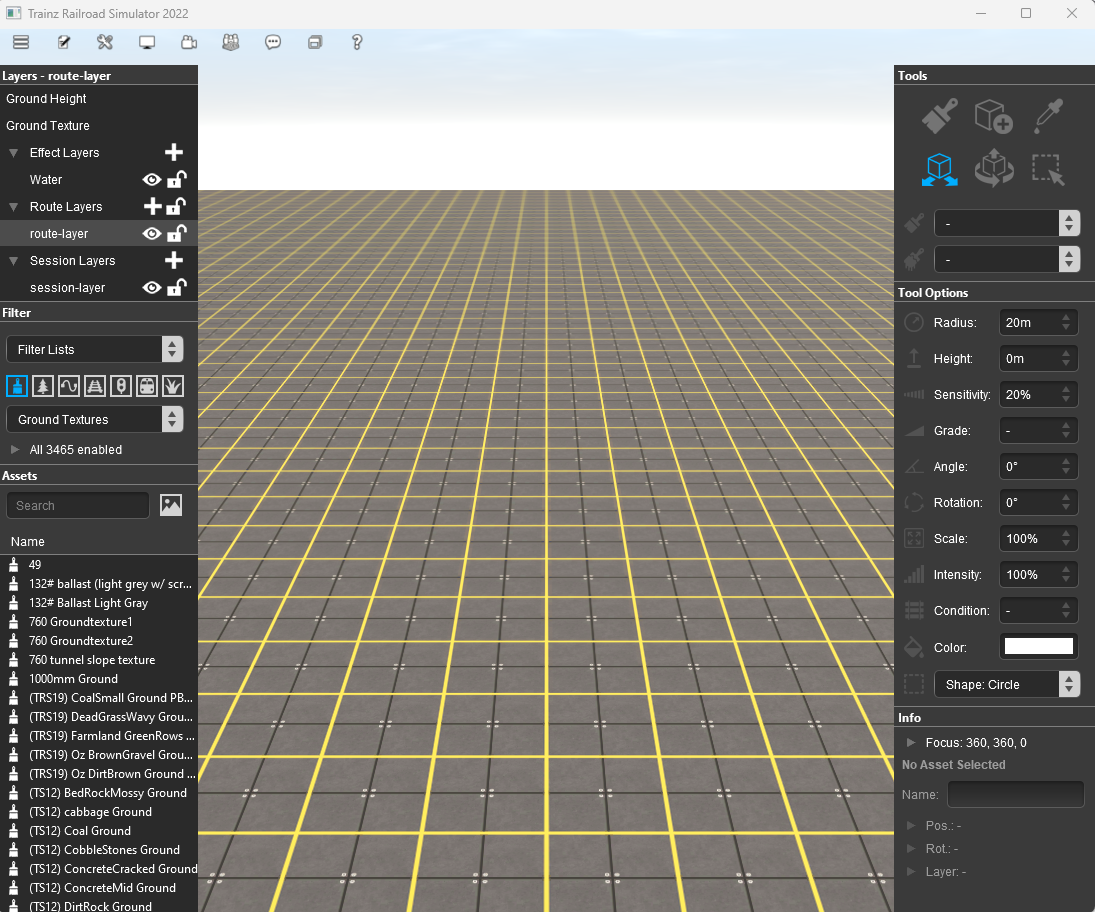
The grey boxes on the left and right of the screen are Palettes, where selections can be made, information displayed and controls set.
|
|
||||||||||||||||||||||
Hiding and Showing Palettes
Palettes are hidden and revealed using the Window Menu on the top Surveyor Menu bar.
The 5 visible and 3 hidden Palettes in the screenshot image shown above have been configured by:-
|
|
||||||||||||||
Docking and Undocking Palettes
Resizing Palettes
Closing Palettes
This is the same as hiding a palette. Once a palette has been undocked it can be closed (hidden) by a Left click on its Close X icon. The palette will not be deleted and can be shown again as described above at Hiding and Showing Palettes
The Info Palette
|
This palette can be easily overlooked but it has some very useful features.
| Its uses are:- | |
| to display precise data on the "focus" - the position of the cursor | |
| to display precise data on the position and attitude of objects | |
| to allow precise control over the position and attitude of objects (i.e. it can be used instead of the Free Move Tool and the Fine Adjustment Tool) | |
| to change the "home" layer and binding layer of a selected object | |
| to lock and unlock layers | |
The Info Palette will appear as shown in the image below.
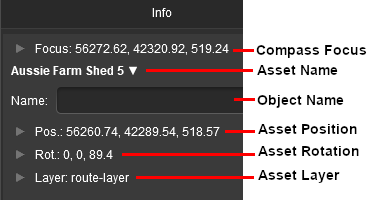 |
Each of the small arrowhead icons will open the palette to display more information and some controls. |
|
||||||||||||||||
Focus Info and Controls
The Focus shows the current position and height of the Cursor object. Open up the Focus by Left clicking on its arrowhead icon.
|
 |
|
Next to the Z co-ordinate is a small white down arrowhead. Left click on the arrow to open its menu.
 |
There is only one item in the sub-menu. Use Height for Brush Left click on the option to copy the current cursor height (Z) value from the Info Palette to the Tool Options Palette Height entry. |
Asset Name Menu
You must have an object (or objects) selected for a name to be shown and the menu to be available.
| If the selected objects are different then a count of the additional objects will be added. The (+2) shown in the object name in the image on the left indicates that "2" additional different objects are in the group of selected objects. The name and position data shown will be for the last selected object. |
Next to the objects name is a small white Down Arrowhead. Left click on the arrowhead to open its menu.
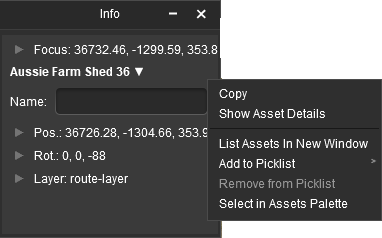 |
The menu options are:-
|
Position Info and Controls
You must have an object (or objects) selected for the position data to be shown and edited. Open up the position data by Left clicking on its Pos: arrowhead icon.
 |
The position of the selected object (or the last object if more than one is selected) is shown in the X, Y and Z text boxes. These values can be edited to move the object or objects to a new position but CARE will be needed.
|
Next to the Z co-ordinate is a small white down arrowhead. Left click on the arrow to open its menu.
 |
There is only one item in the sub-menu. Use Height for Brush Left click on the option to copy the height (Z) value for the selected object from the Info Palette to the Tool Options Palette Height entry. |
Rotation Info and Controls
You must have an object (or objects) selected for the rotation data to be shown and edited. Open up the rotation data by Left clicking on its Rot: arrowhead icon.
 |
The rotational orientation of the selected object (or the last object if more than one is selected) is shown in the R, P and Y text boxes. These values can be edited to rotate the object or objects in 3D space BUT not all objects can be rotated in certain directions. On the right of each box is a pair of Up/Down controls. Left Click and Drag up or down on these to adjust the rotation angle in increments of 1°. |
|
||||||||||||||||||||
Layer Info and Controls
You must have an object (or objects) selected for the layer data to be shown and edited. Open up the layer data by Left clicking on its Layer: arrowhead icon.
|
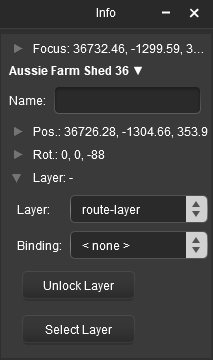 |
This will show the:-
|
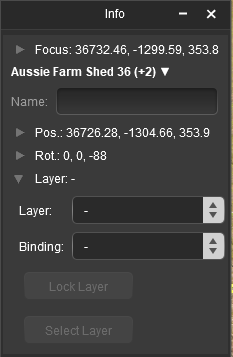 |
If multiple objects from different layers have been selected then no layer name will be shown in the Layer and Binding boxes. Instead they will be left "blank" as shown in the image on the left. Both boxes can still be opened to assign layers to objects. |
Assigning Objects to a Different Layer
A selected object or group of selected objects can be assigned to a different layer. If multiple objects have been selected then they do not have to all be in the same layer.
|
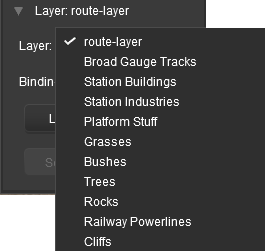 |
|
||||||||||||||
| Once a target layer has been selected then the Select Layer button, which sets the Active Layer, may become active. The Active Layer is the layer used by the Placement Tool when objects are added to a route (or session). This button gives you the opportunity to set the Active Layer to the same layer that you just used to assign to an object. Its use is optional. |
|
||||||||
Assigning Objects to a Binding Layer
| The Binding Layer, or Bound Layer as it is also called, is a tool used in the development of a route or session. It allows you to temporarily assign an object to a second layer while it is still in its original layer. The object will then take on the properties (Locked/Unlocked, Hidden/Visible) of both layers. |
| So if the original layer or the binding layer of an object is:- | |
| LOCKED then the object will be LOCKED | |
| HIDDEN then the object will be HIDDEN | |
|
||||||||||||
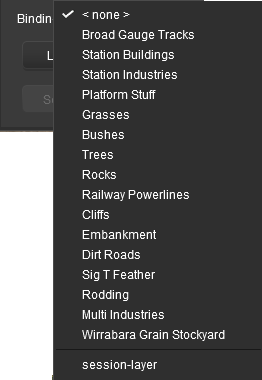 |
|
|||||||||||
| As an example, the image below shows what you will see for a single object that has had:- | |||||||||
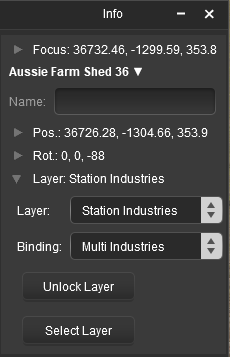 |
|
||||||||
 |
More information on creating, editing and using Layers can be found on the Trainz Wiki at:- |
The Tools Palette
|
| The Tools Palette is at the core of the new interface and takes the place of all the Tool Flyouts that have been the standard for Trainz Surveyor for many years now. Some of the tools are new while others have been given a makeover and new abilities. | |
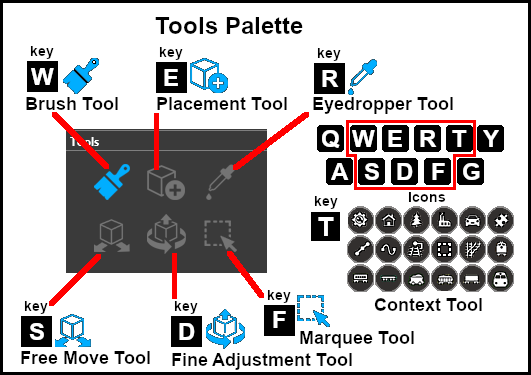 |
The Context Tool is attached as an icon to a selected or newly placed object. The icon and its Context menu will vary according to the type of object. |
For a detailed description of all the tools in the Tools Palette see the Trainz Wiki page How to Use the Surveyor 2.0 Tools
|
The Brush Tool
| Keyboard Shortcut: W | The Brush Tool "paints" the ground height, ground textures, effect layers and scrapbook scenes in a route |
The Placement Tool
| Keyboard Shortcut: E | The Placement Tool adds objects to a route |
The Eyedropper Tool
| Keyboard Shortcut: R | The Eyedropper Tool identifies and selects objects in a route |
|
The Free Move Tool
| Keyboard Shortcut: S | The Free Move Tool moves objects around a route |
The Fine Adjustment Tool
| Keyboard Shortcut: D | The Fine Adjustment Tool makes 3D adjustments (XYZ position and rotations) to objects in a route |
The Marquee Tool
| Keyboard Shortcut: F | The Marquee Tool selects the content in areas of a route, creates and deletes baseboards and sets their properties. It can also used in creating Scrapbooks |
The Tool Options Palette
This palette is used by the various tools (listed above) to set controls and parameters. For a detailed description of all the options presented by the Tools Palette for the different tools, see the Trainz Wiki page How to Use the Surveyor 2.0 Tools
The Assets Palette
The Layers Palette
The Scrapbook Palette
This palette manages the Scrapbooks that you have created yourself, installed from other sources (such as the DLS) or came installed with Trainz. It also controls which parts of a scrapbook are pasted or painted into a route.
|
|
||||||||||||||||||||||||||||
|
|
|||||||||||||||||
|
||||||||||||||||||||||||||||||||||||||||||
|
||||||||||||||||||
The Preview Palette
This palette gives a rotating 3D view of a selected asset
The Packages Palette
This palette .
Trainz Wiki
 |
More Tutorials and Guides to Using Trainz |
This page was created by Trainz user pware in February 2023 and was last updated as shown below.


